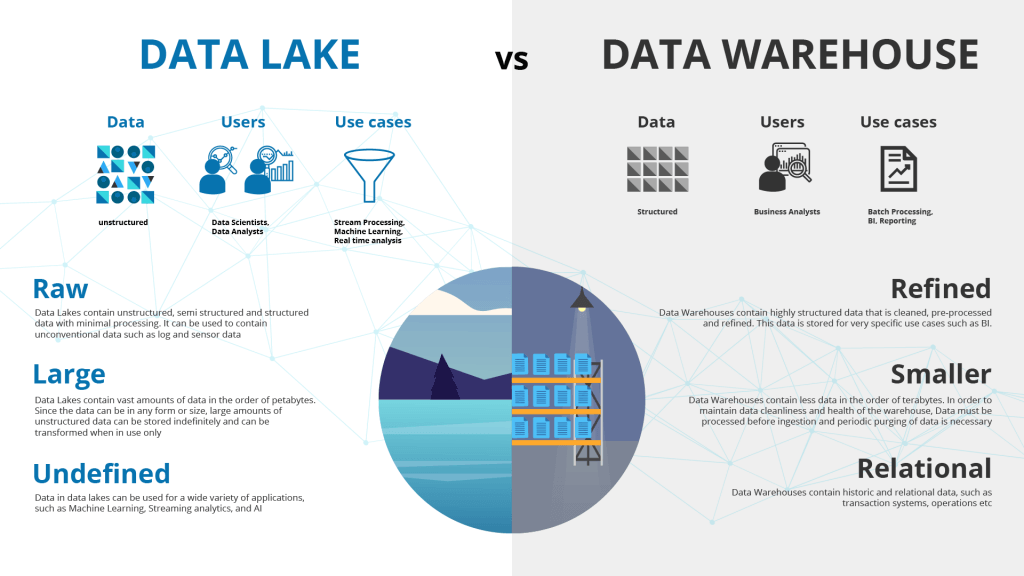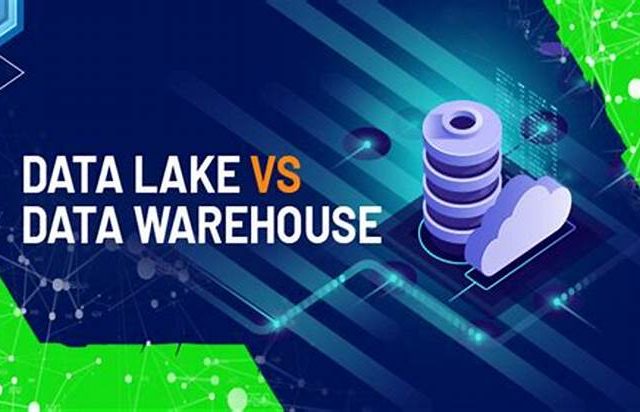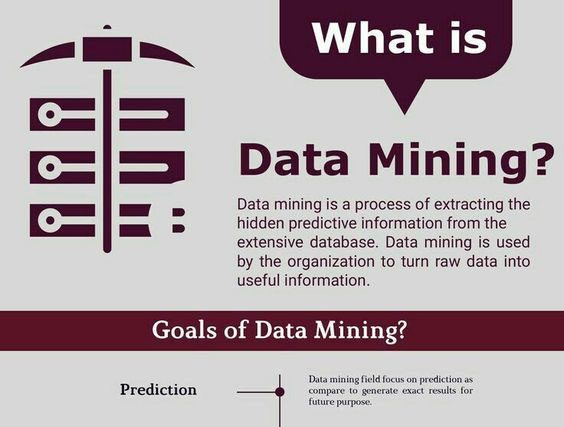Cloud-based storage for big data is top of mind today, whether you are relying on it to conduct day-to-day business or to accomplish specific tasks in business intelligence. AS you know, data drives many business functions, from creating targeted programs for prospects, to optimizing manufacturing and operations processes.
Then you’re probably familiar with the ongoing data lake or data warehouse debate. What you may not know, is that one data platform really isn’t necessarily better than the other. Both storage methods have their own uses, and which method is right for you mostly depends on your business or needs.
Both data lakes and data warehouses collect, store, and surface data in different ways. To understand which platform is right for you, you’ll have to figure out what kind of data storage you need. Here’s everything you should know about the pros and cons of both platforms to help you understand which data storage is right for you.
Let’s start with the basics and know, how a data repository may be necessary to serve the needs of your business.
What is a Data Warehouse?
Data warehouse is a unified data repository for storing large amounts of information from multiple sources within an organization. Data warehouse represents a single source of data truth in an organization and serves as a core reporting and analytics component. They periodically pull information from transactional systems, line of business applications and more.
After pulling data, these warehouses transform it into a standardized schema that matches info already stored in their database. This data model is called schema on write, because the platform writes the schema before implementing it. After implementation, the platform categorizes information contained inside it according to different predefined files and folders.
Schema on write helps make data as easy for analytics tools to use as possible and making it useful for data scientists to use in data mining, artificial intelligence, and machine learning.
Data warehousing could be used by a large city to aggregate electronic transactions from various departments, including excise tax payments and other transactions. This structured data would be analyzed by the city to issue follow-up invoicing and to update census data. It could also be used by a developer to aggregate terabytes of data generated by sensors on automobiles to aid in the decision-making process for an autonomous driving solution.
Data warehouse is a type of database that caters to relational data that stems from transactional applications. It is structured and allows users to make quick queries to use for reporting purposes.
Benefits of Data Warehouse
- Data warehouses define everything they manage in advance in a process called database optimization. You can store all data required for reporting under a single category, even if you need to combine it from multiple sources.
- The platform defines, cleans, standardizes and structures data according to your needs.
- Increasing the power and speed of data analytics and business intelligence workloads. Warehouses save data engineers tons of time by allowing them to access the specific types of information they need. Since the data warehouse’s data is consistent and accurate, they can effortlessly connect to data analytics and business intelligence tools.
- Data warehousing improves decision making by providing a single repository of current and historical data. Decision makers can evaluate risks, understand customers’ needs, and improve products and services by transforming data in data warehouses for accurate insights.
- Data warehousing bridges the gap between raw data and the curated data that offers insights. They serve as the data storage backbone for organizations and allowing them to answer complex questions and use these answers to make informed decisions.
What is a Data Lake?
Data lake is single, central repository for collecting large amounts of data. The major difference is that data lakes store structured, semi structured and unstructured raw data.
This data is aggregated from various sources and is simply stored. It is not altered to suit a specific purpose or fit into a particular format. To prepare this data for analysis involves time consuming data preparation, cleansing and reformatting for uniformity.
Warehouses use schema on write when information is added, while lakes use schema on read. In schema on read, information is only formatted when it’s read, or queried in real time. Data lakes tend to be most useful for professionals such as data scientists or analysts with experience organizing and evaluating data according to custom and business-specific needs.
Benefits of Data Lake
- Data lakes allow users to store massive amounts of data in its native format without organizing. This allows great flexibility for analyzing things like syndicated, and Big Data, where structural consistencies from different sources become problematic for a warehouse.
- Data in data lakes is stored in an open, and raw format, making it easier to apply various machine learning models and deep learning algorithms to process the data to produce meaningful insights.
- Users can access all information much more easily and in real time.
- Keeping information in its original format is a big advantage. They can begin uploading as soon as the lake is ready. They’ll also be able to upload any information directly from any source system.
- Data lakes support many users and use cases more easily than warehouses. They are particularly useful for professional business analysts diving deep into a company’s many data sources. Analysts can use data lakes to gain big picture insights.
- Data lakes are less expensive than data warehouses. They are designed to be stored on low-cost hardware.
Data lake is a centralized source where you store your structured data and unstructured data. It doesn’t require any special structure or organization.

Which cloud-based storage solution should I use?
Clearly, these data storages aren’t necessarily better or worse than each other. Instead, each is more effective at different functions and for different experts. Warehouse is ideal for organizing data required for predefined purposes such as reporting, which makes them great for finance and business functions. Meanwhile, lake is better for collecting large quantities of data for insights and strategic questions, which makes them more effective for customized data analysis.
You should evaluate your options carefully to determine what solution will best serve your needs. Consider the following tips:
- Your business and technology goals.
- Your budget.
- The volume of data.
- How frequently you will need to access data.
These considerations will help you determine what solution will help you reach your goals.
Recommended for you:




MOST COMMENTED
Tutorial
Important Methods in Matplotlib
Machine Learning
Bias and Variance Tradeoff Machine Learning
Tutorial
Multiclass and Multilabel Classification
Machine Learning
Reinforcement Learning in Machine Learning
Deep Learning
Alexnet Architecture Code
Machine Learning
Machine Learning Models Explained